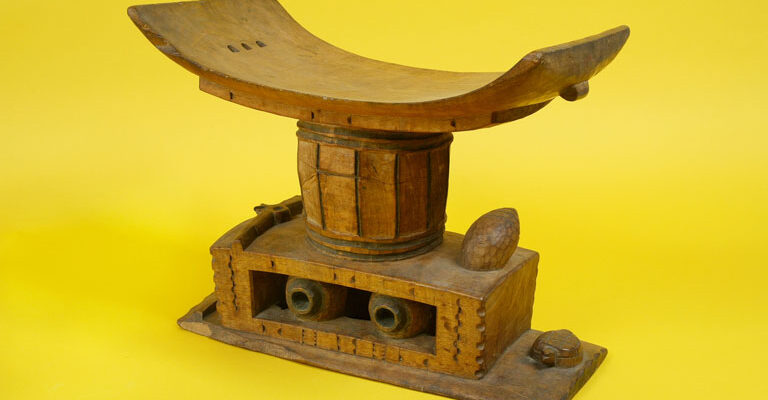The Queenmother of the Akan: Ecological and Theological Implications

By Carine Amo-Nyampong
The Akan people of Ghana traditionally practice a chieftaincy model that has been a harmony between femininity and masculinity. A chief (Ohene) is a symbol of masculinity, so that even if a female becomes chief, she is recognised as a king. The queenmother (Obaahemaa) is the symbol of femininity and is always a female.
Interestingly, this harmonious gender model is reflected in the Akan image of God. Akan cosmology projects God as transcending male or female constructs but intervenes in human affairs through androgynous symbols. For instance, Obaatanpa Onyankopɔn (God the good mother) is a common appellation of God used in religious proceedings. Onyankopɔn ne Ohene (God is King) is another example of God perceived in androgynous terms. However, in the Akan understanding of rulership, a female can equally ascend a throne to become Ohene (chief). Yet Onyankopɔn, a term which may be translated as the “Greatest of all Spirits”, is not known as Obaahemaa.
Against this background, in my research I seek to investigate if a feminine perception of God (Onyankopɔn) was feasible through the symbol of the Obaahemaa (queenmother). As today most Akan are Christian, could the traditional model of chieftaincy offer a starting point for developing an Akan feminist theology? Such a theology could help to disrupt and transform the patriarchal image of God that, in the words of Mercy Oduyoye, was “enthroned” by European missionaries.
In a survey I conducted among Trinity Theological Seminary (TTS) students, 6 out of 19 respondents were not familiar with the Obaahemaa's position. Out of the 6 who were not familiar with the Obaahemaa position, only one was not of Akan ethnicity. Even if the data is interpreted as a general lack of familiarity with contemporary Ghanaian chieftaincy, it is inconsistent that people know about the chief and not his queenmother. Akans believe that every person is a result of their father's spirit and their mother's blood. Hence, lineage is traceable through the mother's bloodline, making the Akan matrilineal. The Obaahemaa is the royal ancestress of every clan, implying that she is not just the mother of the traditional area but the originator of a clan. Among other duties, the queenmother is responsible for selecting a chief in the situation where a chieftaincy seat becomes vacant. The Obaahemaa nominates a chief and reserves the power to destool the same. The disparity between the position of the Obaahemaa and what is known of that position is accounted for in the general domestication of Ghanaian women in the post-colonial and mission era. Thankfully, that is significantly changing though not at the pace at which it should.
The position of the Obaahemaa throws light on what a feminine perception of God, to the Akan mind, could look like. God, as the Creator, is the originator of humanity, as the Obaahemaa. God, as Providential, is the provider for humanity, as the Obaahemaa is the nurturer of her jurisdiction. Biblical imagery of the motherhood of God is abundant and well-documented. Thinking of God in feminine terms through the symbol of the Obaahemaa portends a holistic consideration for all of creation, human and non-human. In fact, the term for a royal person in Akan is Odehyeɛ from Ono na ode ne hyeɛ, directly translated as the one who owns the boundaries of their land. Implying that the Obaahemaa, as royalty, is responsible for her lands. Interestingly, the Obaahemaa is also the custodian of Asaase (earth).
Asaase is understood as the feminine principle of Onyankopɔn, treated with much reverence but not worshipped. The ecological implication of such knowledge is the responsible use of natural resources. After all, it is the land or earth that brings forth riches for its inhabitants. In this sense, a regard for the Obaahemaa is a regard for Asaase and vice versa. I argue that the lopsided view of God in predominantly masculine terminology emphasises androcentrism and its consequent disregard for non-humans. A case in point is galamsey (illegal small-scale mining), which has left many rivers and forests on Akan land in deplorable states. Queenmothers, unsurprisingly, are not represented on the national house of chiefs, a body that is supposed to represent all traditional rulers in Ghana. Obaahemaa Onyankopɔn means a recognition of the Obaahemaa as the tangible symbol of the appellation being proposed.
If God is King, then God is certainly Queenmother if the Akan chieftaincy context is anything to write home about. The position of certain Christian theology that God in masculine designation is a reality of the incarnation (because Jesus Christ is male), forgets that the incarnation is about God becoming human, not God becoming male. Therefore, a more holistic perception of God, such as Obaahemaa Onyankopɔn, is a way forward for inclusion both towards human and non-human. It offers a concept that serves as basis for a more robust ecological care from a theological point.
In essence, Obaahemaa Onyankopɔn is an attempt at creating an encompassing terminology for God drawing from the Akan chieftaincy model. This innovative concept holds profound ecological implications, as it aligns with the symbolism of the queenmother who is a representative symbol inherently connected to the earth, encouraging a sense of reverence. In this context, the earth symbolises a repository of invaluable natural resources, intended for humanity's use, yet deserving of utmost care and preservation.
Carine Amo-Nyampong recently completed her MTh at Trinity Theological Seminary, Legon, Ghana. She participated in the "African Ecologies" workshop, hosted at the British Institute in Eastern Africa, 29-31 July 2023 in collaboration with the Leeds University Centre for African Studies. This blog post is an abbreviated version of the paper presented at the workshop.
